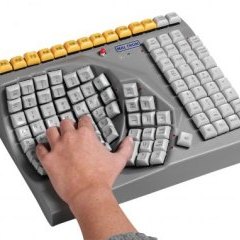

Between two different tasks, people must do a kind of "mental 'gear changing'" that can include "retrieving goal states" and "condition-action rules… enabling a different response set and adjusting response criteria." In a 2003 paper, one researcher examined how switching between two tasks affected performance as opposed to repeating the same task over. "Task switching," which is what we are doing when we change keyboard layouts, does come at a small cost of time and error. The important thing about retaining and calling up this information isn't the sheer number of the alternative ways of using something but how we are at using it in practice.


But we already do this for many objects: a pen can be used to write in two different languages or alphabets, or to draw-or it can be fashioned into, and used as, a weapon. It seems counterintuitive that we would be able to store two complex, different, and yet similar ways of using the same object. Our "knowledge" of a keyboard layout is tied to the physical object only incidentally, and this makes it relatively easy to switch between two layouts, even on the fly.Įach keyboard layout is what researchers refer to as a task set, or a learned way of interacting with an object. Uncommon though the need for switching keyboard layouts is, it's possible through our ability to quickly switch between two tasks (what's colloquially referred to as multitasking). However, the results showed that switching on a mental level between layouts was possible, "even on a word-by-word basis," Snyder said. According to Snyder's early interpretation of the results, "it's harder for typists to switch from Dvorak to QWERTY than vice versa," she told Ars. Snyder put the typists through a task-switching test where they were cued with a word and instructed to type it in either Dvorak or QWERTY. Not only were the typists able to get their speed up in fairly short order, but they were able to preserve it even while switching between layouts. Simply completing all the training sessions took the typists from an initial speed of around 13.3 wpm-on the order of where I started and roughly where my speed stayed-to 33 wpm.

Last summer, Snyder took a group of skilled QWERTY typists with an average speed of 74 wpm and had them complete 20 training sessions in the Dvorak layout. Kristin Snyder, about how one might mentally store both layouts, Snyder said the process was possible-in fact, she's tested for it. When Ars asked one of the authors of the paper, Dr. This study doesn't address learning multiple layouts, but it does point out that a typist's knowledge of a keyboard is a fairly complex and very internalized, reflexive relationship that depends far more on mental work than the object itself. As the process becomes more automatic, typists' knowledge of a keyboard goes from explicit to implicit-even as they get faster and faster, they become no better at, for instance, knowing where the letter X is on the keyboard they're typing on.įurther Reading Typists who clear 70 wpm can’t even say where the keys are As people learn to type, the motion of hitting a key and the reason for doing so are stored in short-term memory. In a study Ars covered in December, a group of scientists found that even extremely good typists that can hit 72 words per minute or better don't actually know where the keys on the keyboard are. And though some successful switchers warned me that it might be impossible, some preliminary research shows that it may be doable after all. At the outset, it seemed like it would be impossible to store two ways of using the same complex object in my brain at once. Further Reading My quest to learn the Dvorak keyboard layout, the grand finaleĭuring my recent attempt to learn the Dvorak keyboard layout, my goal was to remain proficient in QWERTY, trying to store both layouts in my brain and be able to eventually use them both equally.


 0 kommentar(er)
0 kommentar(er)
